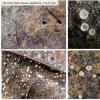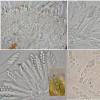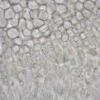
20-12-2025 23:08
Patrice TANCHAUDBonsoir, récolte sur sol sablonneux dans l'arri�

20-12-2025 15:47
Mirek GrycHi.These grew on pine wood that was heavily covere

18-12-2025 21:17
Pol DebaenstThe identification took me to Byssonectria deformi

15-12-2025 07:09
 Danny Newman
Danny Newman
indet. Rutstroemiaceae sp. on unk. fallen leavesMc

19-12-2025 10:10
Patrice TANCHAUDBonjour, récolte réalisée en milieu dunaire, a

18-12-2025 17:23
 Bruno Coué
Bruno Coué
Bonjour,je serais heureux d'avoir votre avis sur c

18-12-2025 18:07
Margot en Geert VullingsThese plumes were found on rotten wood.They strong

17-12-2025 18:35
 Michel Hairaud
Michel Hairaud
Bonjour à tous/Hi to everyone I am passing along
 Bonsoir à tous, Hi to everyone,
Bonsoir à tous, Hi to everyone,Pour la 2eme année consécutive, je récolte sur feuilles pourrissantes de Tilia une minuscule hélotiale blanche sans pouvoir la déterminer
I hereby present a undetermined white Helotialean minute asco on rotten Tilia leaves . I collected it twice in the same site , in November 2012 and 3 days ago.
- Apos up to 0,25 mm, white, urceolate, then flattened, (remaining white) Pars sporifera 18-25 µm
- Ascus H+, IKI + (intense blue) Calycina type, 41-49 x 7-8,5
- EE prismatica, last cells with VBs as in paraphyses
- Spores 7,5-9(10) x 3-3,5 , most often with one, not conspicuous LB at each pole(x -> 1,8 µm) , and not rare detaching envelopes, CRB -
-Paraphyses enlarged ->3-4 , tip filled with a 7-8 µm long VB , CRB +
I would suggest Calycina as a genera candidate but get no clue for species name
I'll be happy with some help . Merci merci.
Amitiés
Michel

I don't have a real idea. Did you observe hairs? Macroscopically the apos look as there wood be some. Arendholz has a Pezizella pilosa (=Hyaloscypha puberula = Calycellina punctata ) that could fit according to his description but not absolutelly to those of the synonyms.
Maybe others will shed a light on this.
Regards
Martin

Are the hairs smooth or warted? But even if they are warted it could be a Calycina (like C. gemmarum). Externally it looks more like a Cistella.
In 1985 I thought P. pilosa is a synonym of Calycellina populina. But this or C. punctata are certainly not your fungus.
Zotto

Hairs are not conspicuous. The last cells of ectal excipulum are up to
15(20) long x 3-4 and are often filled with a VB, as in paraphyses last
cells too. They are smooth.
In Arendholz's description, (Latin diagnose), spores are uniseriate (if I do
understand clearly) , which is not the case here. Also I do not find these apos are erumpent.
Amitiés
Michel

Now I found my photos of Helotium subcitrinum (?= Pezizella pilosa), which is definitely another fungus (HB 8351b).
Zotto

Arendholz describes his Pezizella pilosa in the German diagnosis as with asci oblique uniseriate to irregular and sometimes biseriate. I am sure that he refers to dead herbarium collections mostly. As for the hairs he does not mention any ornamentation. I would consider them as smooth, otherwise he would have mentionend something (cf. warty ). This species on Tilia leaves seems to be a species that needs much more collections.
Best regards
Martin

The copy I have of Arendoltz thesis does not enable me to consider properly the plate for P. pilosa. But I do not think it contains either spore drawings ?
This work is interesting for the description and notes he gives on a good deal of folicolous species.
Michel



